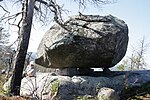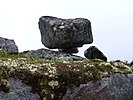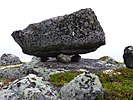Sieidi
Sieidis (Northern Sami: sieidi, Finnish: seita, Swedish: sejte, Russian: сейд) are Sami cultural items, usually a rock with unusual shape. Sieidis are found in nature in certain sacred places, for example at the sea or river beaches or on the mountain.[1] The word sieidi has also been used for holy rocks or wooden figures that have undergone some processing. The victory was a symbol of the divine power ruling over the natural resources that humans needed for their survival. Samis sacrificed parts of their catch at sea to get a successful hunting or fishing in the future.
In southern Sami, the name varies between viero-gierkie (sacrifice stone), viero-moere (sacrificial wood), soul-gierkie (goose-goat) and soul-nut (goose-tree).
Physical characteristics
Each stone is different from the others, and they might vary in form and size. They could be small rocks below a meter of highness but also high stones of more of ten meters. They don't have specific forms but sometimes they remind anthropomorphic features or have other peculiar forms.[2] Their natural form makes it difficult to recognize them in the Sami landscape and don't confuse them with other normal stones. In fact, most of the sieidis which are still known these days are remembered because of written or oral traditions, but other sieidis sites have been probably forgotten.[3]
Rituals and sacrifices
One of the most relevant features of the Sami sacred landscape, the sieidis, consist of wood poles or, more commonly, of stones not modified by humans. Many sacrifices occurred at sieidis sites, and these were always connected to the lives of the Sami population. Sami used to do offers and sacrifices to ask help to the sieidis, for example during sickness, but also for assistance in everyday's tasks and duties. Fisherman offered fish before going fishing and others offered meat before going hunting. The relationship between these stones and the population was considered to be reciprocal. In fact, sacrifices were usually promised before trips and hunt or fishing expeditions; if the trips were a success the Sami respected their promises, if not they could destroy the sieidi which didn't help them. Meat, fish and bones were the most common offers, but there were also other types which included coins, metal objects, jewelry, cheese, and glass.[3][2]
Gallery
- Siedi in Balsfjord.
- Siedi in Saltfjellet.
- Siedi on the Mount of Vottovaara in Karelia
- Siedi near the village of Tumanny
- The same siedi near Tumanny
- Siedi near Tumanny[4]
- Siedi at the top of Nuorunen
- Man-made siedi near the lake Seydozero
References
- ^ Fjellström, Phebe (1986). Lappish society in tradition and the present day. Stockholm: Norstedt. p. 437.
- ^ a b Äikäs, Tiina (2022). "WHAT MAKES A STONE A SIEIDI, OR HOW TO RECOGNIZE A HOLY PLACE?". Culture Crossroads. 5: 14–24. doi:10.55877/cc.vol5.213. S2CID 253570159.
- ^ a b Äikäs, Tiina. "Archaeology of sieidi stones" (PDF).
- ^ https://vk.com/album41876175_93997119
Bibliography
- Äikäs, Tiina (2022). "What Makes a Stone a Sieidi, or How to Recognize a Holy Place?". Culture Crossroads. 5 (1): 14–24. doi:10.55877/cc.vol5.213. S2CID 253570159.
Further reading
- Äikäs, Tiina; Puputti, Anna-Kaisa; Núñez, Milton; Aspi, Jouni; Okkonen, Jari (2009). "Sacred and Profane Livelihood: Animal Bones from Sieidi Sites in Northern Finland". Norwegian Archaeological Review. 42 (2): 109–122. doi:10.1080/00293650903289641. S2CID 161520570.
- Äikäs, Tiina; Bergmann, Ulrich; Salmi, Anna Kaisa (2012). "An attempt to use blood residue analysis to identify sacrificial practices at sieidi sites". Fennoscandia Archaeologica. 29: 93–104.
- Äikäs, Tiina; Salmi, Anna-Kaisa (2013). "'The sieidi is a better altar/the noaidi drum's a purer church bell': long-term changes and syncretism at Sámi offering sites". World Archaeology. 45 (1): 64–82. doi:10.1080/00438243.2012.759510. S2CID 161780518.
- Äikäs, Tiina; Tolonen, Siiri (2016). "Experiencing a Ritual Space – Results of Phosphate Analyses from Four Sámi Offering Places". Norwegian Archaeological Review. 49 (2): 134–155. doi:10.1080/00293652.2016.1231217. S2CID 164249767.
- Fonneland, T. A. (2017). "Ein sieidi si rolle i religionsutøving i samtida: Skiftande tolkingar og tilnærmingar". Tidsskrift for Kulturforskning (in Norwegian). 16 (1): 71–84. hdl:10037/12190.
- Mathisen, Stein R. (2010). "Narrated Sámi Sieidis. Heritage and Ownership in Ambiguous Border Zones". Ethnologia Europaea. 39 (2): 11–25.
- Mundal, Else (2018). "Sami Sieidis in a Nordic Context?". Journal of Northern Studies. 12 (1): 11–20.
- Olsen, Kjell (2017). "What Does the Sieidi Do? Tourism as a Part of a Continued Tradition?". In: Viken, A. and Müller, D. (eds). Tourism and Indigeneity in the Arctic. Bristol, Blue Ridge Summit: Channel View Publications, pp. 225–245. doi:10.21832/9781845416102-015






![Siedi near Tumanny[4]](https://upload.wikimedia.org/wikipedia/commons/thumb/b/b7/Murmansk_Seid_4.jpg/133px-Murmansk_Seid_4.jpg)

